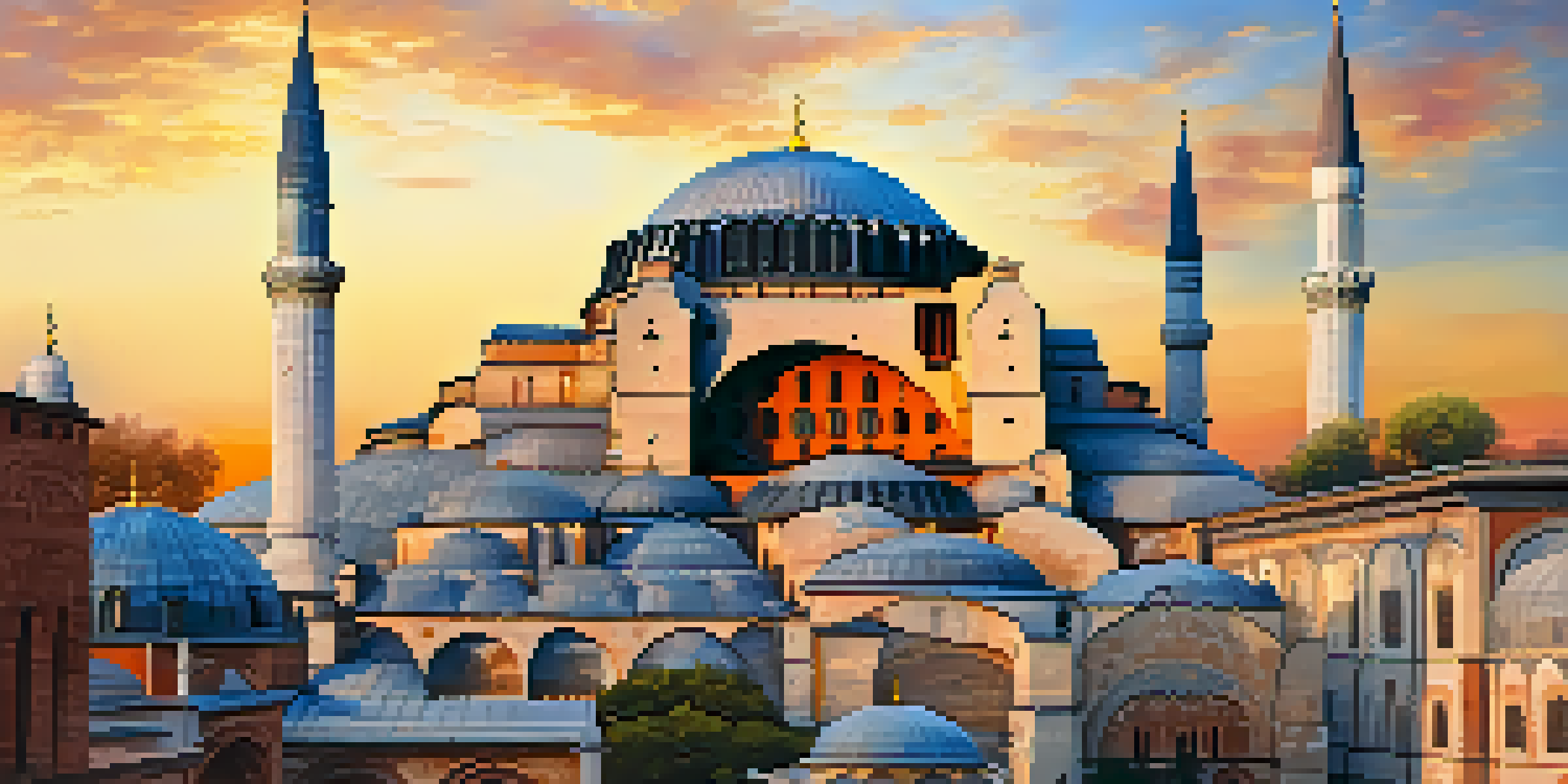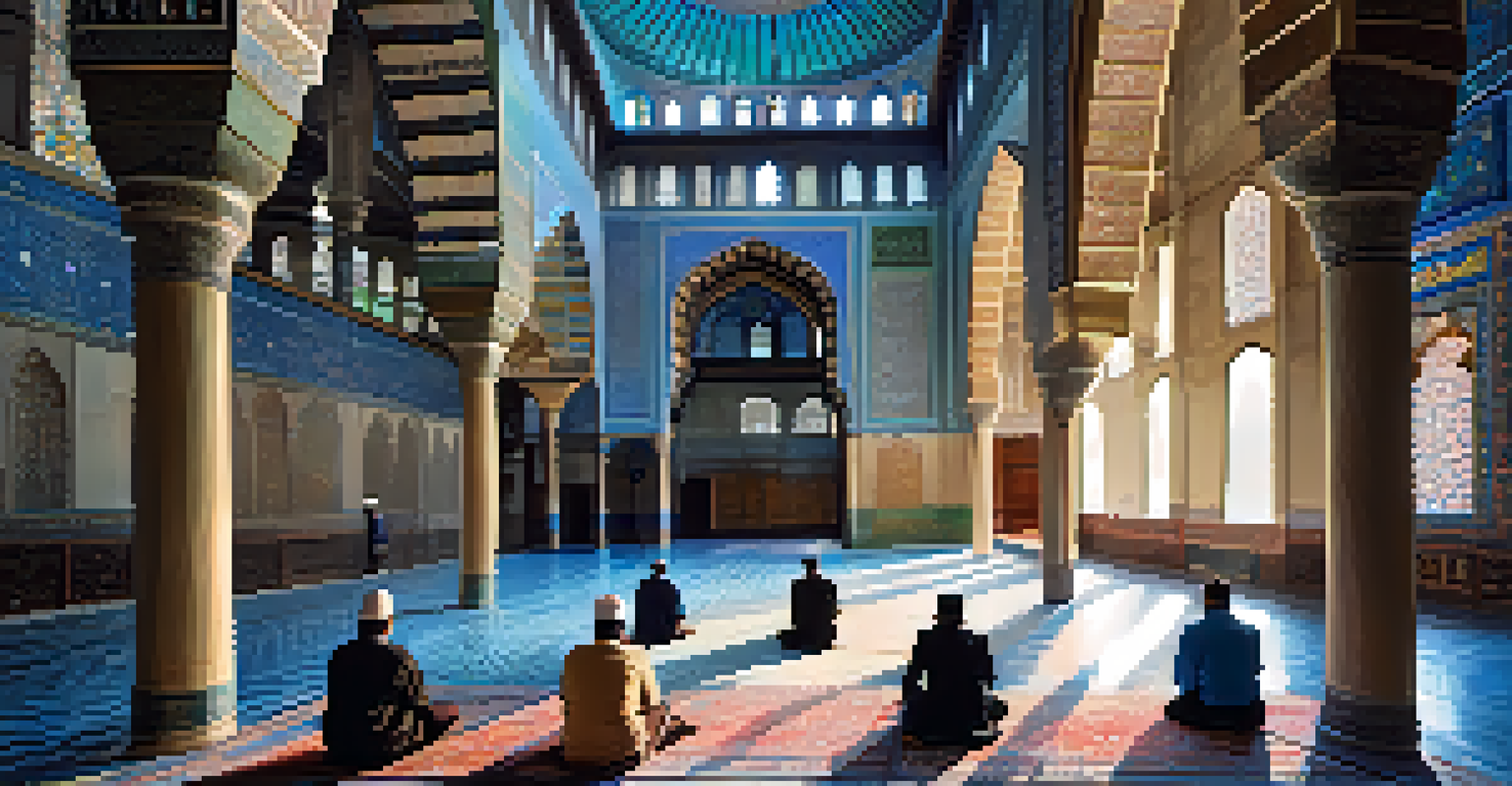Historical Landmarks of Istanbul: East Meets West

The Majestic Hagia Sophia: A Testament to Architectural Brilliance
Hagia Sophia stands as a symbol of Istanbul's layered history, originally built as a cathedral in 537 CE. Its massive dome and stunning mosaics reflect the Byzantine Empire's architectural prowess and religious devotion. After centuries, it transitioned to a mosque, and now serves as a museum, showcasing the city’s multicultural heritage. Visitors often find themselves in awe of the intricate designs that illustrate a narrative of faith and power.
Istanbul is a city of the future, built on the ruins of the past.
The interplay of light through its grand windows creates an ethereal atmosphere, inviting contemplation. As you wander through the vast halls, you can almost hear whispers of the past, from Byzantine emperors to Ottoman sultans. This landmark is not just an architectural feat; it represents the harmonious blend of different cultures and religions that characterize Istanbul.
In essence, Hagia Sophia is more than just a building; it is a bridge connecting the East and West, a living testament to resilience and adaptation. Whether you are an architecture enthusiast or a history buff, the Hagia Sophia offers a profound experience that leaves a lasting impression.
Topkapi Palace: The Heart of Ottoman Power
Topkapi Palace, once the lavish residence of Ottoman sultans, is a sprawling complex that reveals the grandeur of an empire. With its ornate courtyards and exquisite tile work, the palace showcases the opulence of the Ottoman dynasty. Each room tells stories of intrigue, art, and culture, making it a must-visit for anyone interested in this fascinating period of history.

One of the highlights is the Harem, where the sultan's family lived, offering a glimpse into the private life of royalty. The palace also houses sacred relics, including the Prophet Muhammad's cloak, drawing visitors from around the world. As you explore, you can almost feel the weight of history in every corner, where East truly meets West.
Istanbul's Architectural Diversity
The city's landmarks, from Hagia Sophia to the Blue Mosque, showcase a rich blend of cultural and religious influences.
Topkapi Palace not only serves as a historical site but also as a reminder of Istanbul's role as a cultural crossroads. A stroll through its gardens provides breathtaking views of the Bosphorus, further emphasizing its strategic location and significance.
The Blue Mosque: A Marvel of Islamic Architecture
The Blue Mosque, or Sultan Ahmed Mosque, is an iconic landmark known for its stunning blue tiles and six towering minarets. Built in the early 17th century, it represents the zenith of Ottoman architecture, combining grandeur with a sense of tranquility. The mosque's vast prayer hall, adorned with intricate calligraphy and stained glass, invites visitors to experience a moment of peace amidst the city’s hustle.
Architecture is the mother of all arts. It is the most important art because it is the one that gives life to all others.
As you step inside, the soft glow of light filtering through the windows adds to the serene atmosphere. The mosque is not only a place of worship but also a symbol of the city's rich Islamic heritage. Visitors are often struck by the harmonious blend of artistry and spirituality that pervades the space.
The Blue Mosque stands as a testament to Istanbul's cultural diversity, drawing people from all walks of life. Its location, opposite Hagia Sophia, vividly illustrates the historical dialogue between Christianity and Islam, making it a significant site for understanding the city's complex identity.
Basilica Cistern: An Underwater Marvel
Hidden beneath the streets of Istanbul lies the Basilica Cistern, an ancient water reservoir that dates back to the Byzantine era. Known for its eerie ambiance and impressive columns, this underground marvel showcases the engineering prowess of ancient civilizations. As you walk through the dimly lit pathways, the sound of dripping water and gentle echoes create a unique atmosphere that feels almost otherworldly.
The most striking feature is the Medusa heads, intricately carved and positioned as column bases, adding a touch of mystery to the site. This cistern once supplied water to the Great Palace, reflecting the importance of water management in the city's history. Visitors often marvel at the sheer scale and ingenuity of this hidden gem.
Historical Significance of Sites
Each historical site in Istanbul, like Topkapi Palace and Dolmabahçe Palace, offers a glimpse into the city's powerful past and its role as a cultural crossroads.
The Basilica Cistern serves as a reminder of Istanbul's layered past, where each layer tells a story of survival and adaptation. It invites exploration and contemplation, making it a fascinating stop for anyone wanting to delve deeper into the city's historical narrative.
Galata Tower: A Beacon of the City
Rising high above Istanbul's skyline, the Galata Tower offers panoramic views that capture the essence of the city. Built in the 14th century, this stone tower served various purposes, from a watchtower to a fire lookout. Today, it stands as a popular tourist destination, drawing visitors eager to witness the breathtaking vistas of the Golden Horn and the Bosphorus.
The climb to the top is well worth it, as you can see the juxtaposition of old and new architecture that defines Istanbul. The vibrant neighborhoods below pulse with life, showcasing the dynamic culture that thrives in this historic city. It's a perfect spot for photography enthusiasts and anyone wanting to grasp the city's expansive beauty.
Galata Tower is not just about the views; it represents the city's history of trade and cultural exchange. As a former Genoese lookout, it embodies the connections between East and West, making it a significant landmark in understanding Istanbul's rich tapestry.
The Spice Bazaar: A Sensory Journey
The Spice Bazaar, or Misir Carsisi, is a feast for the senses, brimming with vibrant colors and enticing aromas. Established in the 17th century, this bustling market is where East meets West in a delightful display of spices, herbs, and local delicacies. As you wander through the narrow aisles, the rich scents of saffron, cinnamon, and dried fruits envelop you, creating an unforgettable experience.
This market is not just about spices; it’s a social hub where locals and tourists alike gather to shop and savor. You can sample Turkish delights or sip on fragrant tea as you soak in the lively atmosphere. The Spice Bazaar reflects Istanbul's role as a trading center, where flavors and cultures converge.
Culinary and Market Experiences
The Spice Bazaar exemplifies Istanbul's vibrant culinary heritage, where local flavors and social interactions create an immersive experience.
Visiting the Spice Bazaar is more than just shopping; it's an immersion into the city's culinary heritage. Each stall tells a story of tradition and connection, highlighting the importance of spices in both daily life and special occasions.
Dolmabahçe Palace: The Ottoman Empire's Last Flourish
Dolmabahçe Palace showcases the opulence of the late Ottoman Empire, blending European and Ottoman architectural styles. Built in the 19th century, this grand palace served as the main administrative center of the empire. Its lavish interiors are adorned with crystal chandeliers and intricate designs, reflecting the wealth and power of the sultans who lived here.
Visitors can explore the stunning gardens and ornate rooms, each more breathtaking than the last. The palace also holds historical significance, as it was the site of key events, including the death of Mustafa Kemal Atatürk, the founder of modern Turkey. Walking through its halls, you can sense the weight of history and the crossroads of East and West.

Dolmabahçe Palace is a vivid reminder of the empire's last flourish, showcasing the cultural synthesis that defines Istanbul. It invites visitors to appreciate the beauty and complexity of a city that has long been a meeting point of diverse influences.
The Walls of Constantinople: Guardians of History
The Walls of Constantinople are a monumental reminder of the city's storied past, having protected it for centuries. Stretching over 13 miles, these formidable fortifications were built in the 4th century and showcase the engineering skills of the Byzantine Empire. As you walk along the ancient walls, you can almost hear the echoes of battles fought and the resilience of a city that stood against invaders.
These walls are not just a historical relic; they represent the enduring spirit of Istanbul. Many sections have been restored, allowing visitors to explore the towers and gates that once guarded the city. The panoramic views of the surrounding areas further enhance the experience, giving insight into the city's strategic importance.
Visiting the Walls of Constantinople is like stepping back in time, where history unfolds with every step. They serve as a powerful reminder of the city's unique position at the crossroads of East and West, embodying the rich tapestry of cultures that have shaped Istanbul.